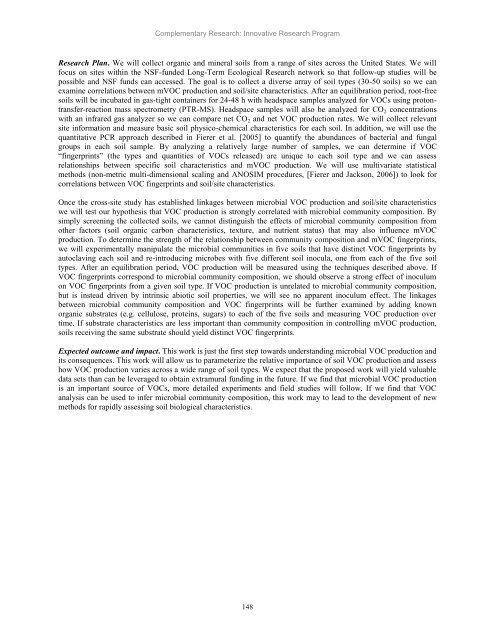Scientific Theme: Advanced Modeling and Observing Systems
Scientific Theme: Advanced Modeling and Observing Systems
Scientific Theme: Advanced Modeling and Observing Systems
You also want an ePaper? Increase the reach of your titles
YUMPU automatically turns print PDFs into web optimized ePapers that Google loves.
Complementary Research: Innovative Research Program<br />
Research Plan. We will collect organic <strong>and</strong> mineral soils from a range of sites across the United States. We will<br />
focus on sites within the NSF-funded Long-Term Ecological Research network so that follow-up studies will be<br />
possible <strong>and</strong> NSF funds can accessed. The goal is to collect a diverse array of soil types (30-50 soils) so we can<br />
examine correlations between mVOC production <strong>and</strong> soil/site characteristics. After an equilibration period, root-free<br />
soils will be incubated in gas-tight containers for 24-48 h with headspace samples analyzed for VOCs using protontransfer-reaction<br />
mass spectrometry (PTR-MS). Headspace samples will also be analyzed for CO2 concentrations<br />
with an infrared gas analyzer so we can compare net CO2 <strong>and</strong> net VOC production rates. We will collect relevant<br />
site information <strong>and</strong> measure basic soil physico-chemical characteristics for each soil. In addition, we will use the<br />
quantitative PCR approach described in Fierer et al. [2005] to quantify the abundances of bacterial <strong>and</strong> fungal<br />
groups in each soil sample. By analyzing a relatively large number of samples, we can determine if VOC<br />
―fingerprints‖ (the types <strong>and</strong> quantities of VOCs released) are unique to each soil type <strong>and</strong> we can assess<br />
relationships between specific soil characteristics <strong>and</strong> mVOC production. We will use multivariate statistical<br />
methods (non-metric multi-dimensional scaling <strong>and</strong> ANOSIM procedures, [Fierer <strong>and</strong> Jackson, 2006]) to look for<br />
correlations between VOC fingerprints <strong>and</strong> soil/site characteristics.<br />
Once the cross-site study has established linkages between microbial VOC production <strong>and</strong> soil/site characteristics<br />
we will test our hypothesis that VOC production is strongly correlated with microbial community composition. By<br />
simply screening the collected soils, we cannot distinguish the effects of microbial community composition from<br />
other factors (soil organic carbon characteristics, texture, <strong>and</strong> nutrient status) that may also influence mVOC<br />
production. To determine the strength of the relationship between community composition <strong>and</strong> mVOC fingerprints,<br />
we will experimentally manipulate the microbial communities in five soils that have distinct VOC fingerprints by<br />
autoclaving each soil <strong>and</strong> re-introducing microbes with five different soil inocula, one from each of the five soil<br />
types. After an equilibration period, VOC production will be measured using the techniques described above. If<br />
VOC fingerprints correspond to microbial community composition, we should observe a strong effect of inoculum<br />
on VOC fingerprints from a given soil type. If VOC production is unrelated to microbial community composition,<br />
but is instead driven by intrinsic abiotic soil properties, we will see no apparent inoculum effect. The linkages<br />
between microbial community composition <strong>and</strong> VOC fingerprints will be further examined by adding known<br />
organic substrates (e.g. cellulose, proteins, sugars) to each of the five soils <strong>and</strong> measuring VOC production over<br />
time. If substrate characteristics are less important than community composition in controlling mVOC production,<br />
soils receiving the same substrate should yield distinct VOC fingerprints.<br />
Expected outcome <strong>and</strong> impact. This work is just the first step towards underst<strong>and</strong>ing microbial VOC production <strong>and</strong><br />
its consequences. This work will allow us to parameterize the relative importance of soil VOC production <strong>and</strong> assess<br />
how VOC production varies across a wide range of soil types. We expect that the proposed work will yield valuable<br />
data sets than can be leveraged to obtain extramural funding in the future. If we find that microbial VOC production<br />
is an important source of VOCs, more detailed experiments <strong>and</strong> field studies will follow. If we find that VOC<br />
analysis can be used to infer microbial community composition, this work may to lead to the development of new<br />
methods for rapidly assessing soil biological characteristics.<br />
148
















